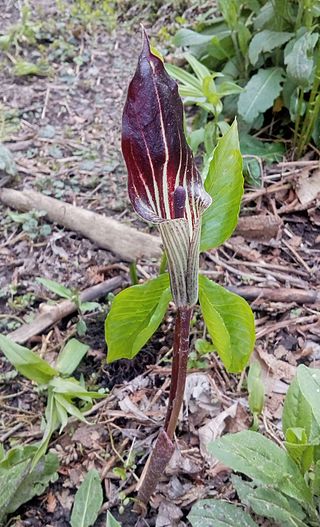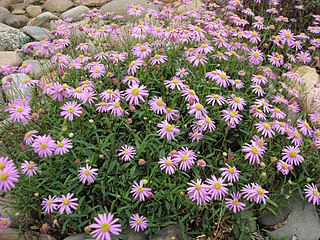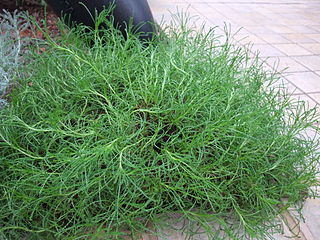
The family Asteraceae, with the original name Compositae, consists of over 32,000 known species of flowering plants in over 1,900 genera within the order Asterales. Commonly referred to as the aster, daisy, composite, or sunflower family, Compositae were first described in the year 1740. The number of species in Asteraceae is rivaled only by the Orchidaceae, and which is the larger family is unclear as the quantity of extant species in each family is unknown.

Senecio is a genus of flowering plants in the daisy family (Asteraceae) that includes ragworts and groundsels.
Harold Ernest Robinson was an American botanist and entomologist.

Eupatorium is a genus of flowering plants in the family Asteraceae, containing from 36 to 60 species depending on the classification system. Most are herbaceous perennials growing to 0.5–3 m (1.6–9.8 ft) tall. A few are shrubs. The genus is native to temperate regions of the Northern Hemisphere. Most are commonly called bonesets, thoroughworts or snakeroots in North America. The genus is named for Mithridates Eupator, king of Pontus.

Arisaema triphyllum, the Jack-in-the-pulpit, is a species of flowering plant in the arum family Araceae. It is a member of the Arisaema triphyllum complex, a group of four or five closely related taxa in eastern North America. The specific name triphyllum means "three-leaved", a characteristic feature of the species, which is also referred to as Indian turnip, bog onion, and brown dragon.

James Lauritz Reveal was a U.S. botanist best known for his contributions to the genus Eriogonum and for his work on suprageneric names. His website, at PlantSystematics.org, also presents material on plant taxonomy including the Reveal system. He published extensively on North American flora, was a member of the Angiosperm Phylogeny Group, and was one of the authors of the APG II and APG III classifications.

Santolina is a genus of plants in the chamomile tribe within the sunflower family, primarily from the western Mediterranean region.

Brachyscome is a genus of flowering plants in the family Asteraceae. Most are endemic to Australia, and a few occur in New Zealand and New Guinea.

Santolina chamaecyparissus, known as cotton lavender or lavender-cotton, is a species of flowering plant in the family Asteraceae, native to the western and central Mediterranean.

Eutrochium is a North American genus of herbaceous flowering plants in the family Asteraceae. They are commonly referred to as Joe-Pye weeds. They are native to the United States and Canada, and have non-dissected foliage and pigmented flowers. The genus includes all the purple-flowering North American species of the genus Eupatorium as traditionally defined, and most are grown as ornamental plants, particularly in Europe and North America.

Dudleya greenei is a perennial species of succulent plant known by the common names Greene's liveforever, or Greene's dudleya. It is endemic to the Channel Islands of California, where it grows along the cliffs of four of the eight islands. It is a highly variable plant, presenting with multiple forms and varying levels of ploidy. Taxonomically, this species is an insular segregate of Dudleya caespitosa, and was placed as a stopgap taxon by Reid Moran in his 1951 thesis on the genus. It is characterized by white or green leaf rosettes, loomed over by inflorescences bearing pale yellow to white flowers. It is a member of the subgenus Dudleya, as it cannot be propagated from leaf cuttings, does not grow from a corm, and has tight petals.

Antennaria rosea is a North American species of flowering plant in the family Asteraceae known by the common name rosy pussytoes. Other common names include cat's foot and mountain everlasting. The second part of its scientific name, rosea, is Latin for pink. It is widespread across much of Canada including all three Arctic territories, as well as Greenland, the western and north-central United States, and the Mexican state of Baja California.
Phytophthora tentaculata is a plant pathogen that causes root and stalk rot. It was first isolated in 1993 in a nursery in Germany infecting Chrysanthemum, Verbena, and Delphinium ajacis. It has since been found infecting a Verbena in Majorca, Spain in June 2001 but was thought to be restricted to nurseries in Germany and the Netherlands. Other species have since been found to be infected, Santolina chamaecyparissus in Spain in 2004, Gerbera jamesonii in Italy 2006, and Aucklandia lappa in China in 2008.

Otanthus is a genus of flowering plants in the chamomile tribe (Anthemideae) within the daisy family. The only known species is the cotton weed plant, Otanthus maritimus. It is a small pioneering perennial that grows in the dune areas throughout the Mediterranean and exerts a stabilizing action on the sandy soils. A thick white down covers both the stems and the small oval, slightly saw-toothed alternate leaves. The globose flower heads, with their short peduncles, are composed of an envelope of white-wooly scales around tubular yellow flowers that are visible from June through to September. The generic name is derived from the Greek words otos (ear) and anthos (flower). This refers to the form of the corolla, which is composed of three membranous bracts that create a profile similar to that of a human ear.

Santolina rosmarinifolia, the holy flax, is a species of flowering plant in the daisy family Asteraceae, native to south western Europe. It is a dense, compact evergreen shrub growing to 60 cm (24 in) tall and wide, with narrow, aromatic green leaves and tight yellow composite flowerheads carried on slender stalks above the foliage, in summer.
Guy L. Nesom is an American writer and botanist.

Arctotis venusta is a species of South African plants in the family Asteraceae. Common names include silver arctotis, kusgousblom, and blue-eyed African daisy. It is native to South Africa, Lesotho, Botswana, Namibia, and Zimbabwe. The species is widely cultivated as an ornamental, and has become naturalized in parts of the United States, Australia, and Central and South America, where it has escaped from gardens to become a noxious weed.

Santolina pinnata, called lavender cotton along with other members of its genus, is a species of flowering plant in the family Asteraceae, native to northwest Italy. Its putative subspecies Santolina pinnata subsp. neapolitana, the rosemary-leaved lavender cotton, has gained the Royal Horticultural Society's Award of Garden Merit.
















